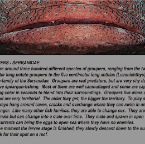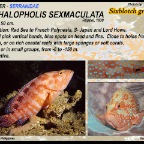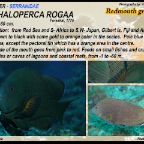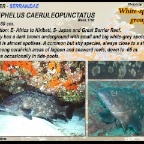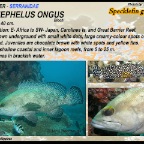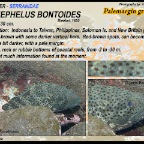Groupers - Serranidae
GROUPERS - SERRANIDAE
There are around three hundred different species of groupers, ranging from the two and a half meter long potato groupers to the five centimeter long anthias (Luzonichthys), which is a sub-family of the Serranidae. Groupers are real predators, but are very shy due to extensive speargun-fishing. Most of them are well camouflaged and some are capable of changing color in seconds to blend into their surroundings. Groupers live alone or in pairs and are very territorial. The older they get, the bigger the territory. To play safe, they always hang around caves, cracks and overhangs where they can swim in and hide from danger. Like many other fish families, they are able to change sex. They are always born female but can change into a male over time. They mate and spawn in open water so the currents can bring the eggs to open sea where they have no enemies. From the moment the larvae stage is finished, they slowly descent down to the substrate and look for their spot on a reef. Length: 60 cm.Distribution: E- Africa to Kiribati, S- Japan and Great Barrier Reef.The body has a dark brown underground with small and big white-grey spots, the head is almost spotless. A common but shy species, always close to a sheltered area. Among coral-rich areas of lagoon and seaward reefs, down to -65 m. Juveniles occasionally in tide-pools. Length: 52 cm.Distribution: from the Red Sea to Line Isl., Ryukyus and Great Barrier Reef.Cream-green underground with orange spots and white horizontal lines, these lines disappear on adults. Among coral-rich areas of clear lagoon and protected seaward reefs, down to -50 m. Feeds primarily on small fishes. Length: 65 cm.Distribution: from E- Africa to S.W- Japan, Samoa and Australia.Very similar to V. louti, but has a white margin on tail fin and a larger yellow area onpectoral fins. Shows often pale saddles on back. Feeds on fishes. Solitary, but sometimes in small groups. In lagoons and on coastal- and outer reefs, from -4 to -200 m. Length: 40 cm.Distribution: E- Africa to SW- Japan, Carolines Is. and Great Barrier Reef.Dark brown underground with small white dots, large creamy-colour spots on body and head. Juveniles are chocolate brown with white spots and yellow fins.Among shallow coastal and inner lagoon reefs, from 5 to 25 m.Sometimes in brackish water. Length: 50 cm.Distribution: Red Sea to French Polynesia, S- Japan and Lord Howe.Red and pink vertical bands, blue spots on head and fins. Close to holes from steep dropoffs, or on rich coastal reefs with large sponges or soft corals. Solitary or in small groups, from -6 to -150 m. Night-active. Length: 90 cm.Distribution: from the Red Sea to Fiji and South Africa.Blue dots on the head, ground color(red to brown) with blotches and bars. In shallow lagoon and on seaward reefs down to -147 m. Common in the Red Sea, uncommon to rare elsewhere. Length: 70 cm.Distribution: Malaysian Peninsula to Philippines, Papua New Guinea and Australia. Similar to P. areolatus but less and larger blue spots. From dark brown to red, olive or grey. Elongate blue spots on head and white to pale blue margin on tail fin, blue ring around eyes. Lives solitary on silty coastal reefs, from -5 to -50 m. Length: 80 cm.Distribution: from the Red Sea to SW- Japan, Samoa and Australia.From pale yellow to pale grey with numerous small dark-edged blue spots. Often with 4 to 5 pale vertical bands on back and dark fins, white margin on tail fin.Lives solitary in coral-rich areas of lagoons and seaward reefs, from -2 to -20 m. Length: 40 cm.Distribution: Red Sea (uncommon) to Hawaii (imported), S- Japan and Lord Howe.Many small blue spots, with a dark margin around. Around five vertical stripes fromthe middle of the body towards the tail. Common near shallow lagoons and seaward reefs with rich coral growth, from 1 to 40 m. Feeds primarily on fishes. Ciguatoxic in certain area! Length: 80 cm.Distribution: Red Sea to French Polynesia, S- Japan and New Caledonia.Posterior margins of all fins broadly yellow. Ground colour variable, lavender to red. Blue dots can change into small lines during the years. Feeds primarily on fishes, occacionally on crustaceans. Common in many areas, among coral-rich areas of lagoons and seaward reefs from 1 to -150 m. May be ciguatoxic in some areas. Length: 32 cm.Distribution: E- Africa to SW- Japan, French Polynesia and Australia.Light underground with two tones of brown, honeycomb-shape pattern.A very common species in shallow protected lagoons and seaward reefs.Lives solitary, intertidal to -50 m but mostly above -20 m.Feeds primarily on crustaceans and fishes. Length: 35 cm.Distribution: from the Comores to Line Isl., Ryukyus to Mauritius and Flores.Yellow body with blue horizontal lines. In or around caves and crevices of deep dropoffs, from 10 to 120 m. Rarely above 25 m.Prefers reefs with many gorgonia corals. Lives mostly solitary. Length: cm.Distribution: Red Sea to French Polynesia, S- Japan and New Caledonia.Grey-ish underground with white blotches and dark brown spots. A typical coral grouper, feeds on fishes and small crustacean.On silty coastal reefs and estuaries, from -5 to -20 m. Length: 23 cm.Distribution: from the Andaman Sea to Flores, Philippines and New Caledonia.Brown-greenish colour with fine blue spots on the head. Is able to change from colour. A very shy species. Always amongst a shelter on shallow silty reefs, down to -30 m. Length: 38 cm.Distribution: from the Andaman Sea to SW- Japan, Papua New Guinea and Australia. White-greyish body colour with polygonal spots in different shades of brown.4 to 5 dark-brown diagonal bands on body, white tips on front dorsal fin.Lives solitary on silty coastal reefs, from -1 to -50 m. Length: 120 cm.Distribution: Red Sea to SW- Japan, Tonga, New Caledonia and Great Barrier Reef. Grey-brown mottled pattern with diagonal dark bands. Pale blotches and numerous small black spots, these increase with age. Feeds primarily on fishes and crustaceans.Solitary, at protected areas of coastal reefs, lagoons and estuaries. To -100 m. Length: 60 cm.Distribution: E- Africa to S- Japan, Samoa, Lord Howe Is. and S.E- Australia.Brown-greyish with dark brown spots, two white saddles on back. Small juveniles are black with white blotches, and become more spotted with age. Front part of dorsal fin is about 50% taller than on other species. Juv. are found on coral rubble and between rocks. In lagoons, coastal- and seaward reefs, from -2 to -82 m. Can be ciguatoxic. Length: 270 cm.Distribution: Red Sea and E- Africa to SW- Japan, E- Fr. Polynesia and Australia.The largest of all coral fish and very rare. From white-grey to olive green or dark brown. A mottled pattern on body and head, which changes during time. Yellow fins with small black spots or blotches. Feeds on fishes and large crustaceans, like spiny lobsters. Solitary, in holes or shipwreck’s of deep lagoons and outer reefs to -100 m. Length: 44 cm.Distribution: from Andaman Sea to S- China Sea, SW- Japan, Samoa and G.B.R.Blotched grey-brown with greyish patches and numerous black spots.Dark saddles on back and tail- and dorsal fins. White margin on dorsal, anal and tail fins. Juveniles with large white patches. Solitary, in lagoons and on seaward reefs, from -1 to -37 m. Length: 30 cm.Distribution: Indonesia to Taiwan, Philippines, Solomon Is. and New Britain (PNG).Greyish-brown with some darker vertical bars. Red-brown spots, can become paler. All fins a bit darker, with a pale margin. On mud, rock or rubble bottoms of coastal reefs, from -2 to -30 m. Rare, not much information found at the moment. Length: 40 cm.Distribution: from the Red Sea and E- Africa to SW- Japan, Fiji and NW- Australia.White to grey body with numerous large orange-brown spots which become smaller with maturity. Narrow white margin on tail fin and rear part of dorsal fin.Lives solitary on areas with seagrass and small coral formations.Prefers bottoms with fine sediment, down to -200 m. Length: 40 cm.Distribution: from the Red Sea to Samoa, S- Japan and Lord Howe.Orange-red with many blue spots, juveniles orange-yellow with blue spots.A very common grouper who mostly is not shy. Lives in channels and on seaward reefs in coral-rich areas with clear water, down to 150 m.Feeds primarily on fishes, occasionally on crustaceans. Length: 27 cm.Distribution: from E- Africa to SW- Japan, French Polynesia, N. Caledonia, Australia. Redish-brown, becomes darker towards the tail-base. Mostly display faint pale bars. Two diagonal white lines on tail-fin, subspecies from the Indian ocean does not have these lines but has a dark spot on upper gill plate. Feeds primarily on small fishes. Common in coral-rich areas with clear water. From -1 to -60 m. Length: 57 cm.Distribution: from E- Africa to SW- Japan, Line Is. and Great Barrier Reef.From orange-red to red-brown, dense red spotted pattern (especially on the head).Lighter margin on the fins, red eyes and high body profile.Solitary, in lagoons and coral-rich outer reefs. From -10 to -150 m, adults mostly deeper than -30 m. Length: 34 cm.Distribution: from W- India towards S- Japan and Northern Australia.Dark yellow-brown with pale to dark blue lines on body and fins, snout has blue spots. Solitary, sheltered dead or silty coastal reefs, from -1 to -30 m. Not shy. Length: 26 cm.Distribution: from E- Africa to New Guinea, S- Japan and Great Barrier Reef.Light with dark brown striped pattern, fine blue margin at the edge of tailfins. Likes sheltered lagoon reefs down to -20 m, in rocky or coral rich areas. Feeds primarily on crustaceans. Absent from most oceanic islands. Length: 90 cm.Distribution: from the Red Sea to Line Islands, Ryukyus and New Caledonia, Samoa. Typical pattern, has a green to brown colour. Lives around lagoons and seaward reefs, in areas of rich coral growth and clear water down to 60 m. Feeds on fishes, crustaceans and cephalopods.May be cinguatoxic (can contain poison of their prey). Length: 35 cm.Distribution: from Thailand to Philippines, Solomon Islands and W- Australia.Redish-brown with mottled pattern on the head and bars on the body. Small black-edged blue spots, blue margin at rear part of dorsal and tail fin. Younger specimen, grey with yellow to orange tail, anal and rear dorsal fin. Coral-rich areas and seagrass beds of shallow protected coastal reefs, to -50 m. Feeds on fishes and crustacean. Length: 40 cm.Distribution: from the Red Sea to French Polynesia, S- Japan and Lord Howe.Sometimes completely white with a big dark red spot on the head (maybe changes later in a stripy pattern). Not shy, feeds on fishes and crustacean.Primarily on seaward reefs. Length: 70 cm.Distribution: from E- Malaysian Peninsula to SW- Japan, New Caledonia and G.B.R.Adults pale green-brown with black spots, smaller on the head. Juveniles translucent to bright white. Very easy to recognize by the typical pattern and small head. Can be found in lagoons and seaward reefs, down to 40 m.Very shy, more common on dead silty reefs. Length: 60 cm.Distribution: from Red Sea and S- Africa to S.W- Japan, Gilbert Is, Fiji and Australia.Dark brown to black with some gold to orange color in the scales. Pale blue margin on all fins, except the pectoral fin which has a orange area in the centre. The inside of the mouth goes from pink to red. Feeds on small fishes and crustaceans. Near holes or caves of lagoons and coastal reefs, from -1 to -60 m.


